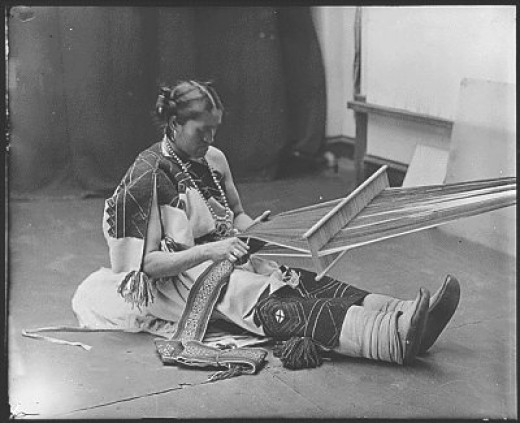
We'wha, a mixed-gender person from Zuni Pueblo in New Mexico, is seen weaving in late 1800s. Photo from National Archives and Records Administration
Among Indigenous Peoples a Third Gender
By Doug George-Kanentiio For many generations western societies have had a difficult time with the issue of proper gender roles. Christian beliefs have neatly separated the world into masculine and feminine elements but have not taken into consideration, or tolerated, variances from these polarities. Hence the active suppression of so-called "deviant" behavior by homosexuals and those who support sexual liberation. But Native peoples refused to be bound by these qualifications and moral judgments based upon a gross misinterpretation of natural law. The universe is based upon infinite variances including sexuality. Native people, in their study of the natural world, knew this. Our societies did not condemn a person for having a combination of feminine and masculine characteristics. In fact, those who cross standard gender lines were considered important members of the community and often held in very high esteem. Native people accepted the general idea of creative and destructive forces at work in the universe yet they also knew the world was not simply black and white. There are endless variations of the two primary colors which make for a more beautiful planet. Some humans, Natives believe, are born with the ability to function as a third gender, neither male or female but a combination of both. Anthropologists call these individuals berdaches, a French term referring to a young male who acted as the submissive partner in a same sex relationship. While generally viewed as homosexual the berdache cannot be restricted along simple sexual lines. They functioned as partners in a relationship while serving their respective communities as healers, spiritual advisors and custodians of sacred objects and rituals. These unique people are called nadle by the Dine (Navajo), lhamana by the Zuni and mihdacke by the Mandan. Most Native nations believed they were important to the spiritual well being of the people because they were extraordinarily close to the creative forces of nature. In the book “The Spirit and the Flesh” by Walter Williams (Beacon Press,) the author points the significance of berdaches in virtually all Indian communities. He notes that Native people were generally quite liberal in their attitudes towards sexual relationships among all three genders. Dr. Williams observes young people approaching puberty were watched closely to see if they demonstrated any inclination to live as a berdache. Since most berdaches were born as males the elders observed those who demonstrated a preference for female pursuits. Rather than forbidding a child from acting on their natural impulses they would be encouraged to discover what role they were to play in their respective community, possibly as a berdache. Their dreams were carefully analyzed while some groups sent the young person to a place of isolation where they would pray for guidance from the spiritual world. Referred to as a ‘vision quest’ the resulting revelation would form the basis upon which the person lived the rest of their lives. In some Native societies a public ceremony was held to initiate the person into his/her roles as a berdache. No coercion or force of any kind was brought to bear on the young person who could, if they desired, slip into a role as a male or female. Certainly, the berdache had a sexual function as well. It was not unusual for berdaches to marry males and sustain a family. They were considered uniquely capable of caring for children, especially those with special needs. This sexual fluidity among Indians caused great concern to Christian missionaries who saw the berdache as a mockery of God. Using the Bible as a weapon they acted swiftly to stamp out this part of Indian culture wherever found. Although not as prevalent as in per-Christian times, the berdache has managed to survive in many Native societies, although somewhat underground. They continue to fulfill their obligations as counselors and spiritual guides with increasing acceptance despite some social constraints. Given their traditional importance to Native people it might well serve others to learn from these blessed individuals. Doug George-Kanentiio is an Akwesasne Mohawk currently residing on Oneida Territory with his wife Joanne Shenandoah.
Join the Conversation
More from Doug George-Kanentiio:Doug George-Kanentiio: Respect treaty right to cross borders (11/10)
Doug George-Kanentiio: Native people play key role in politics (10/09)
Doug George-Kanentiio: Onondaga Nation brings honor to us all (10/01)
Doug George-Kanentiio: Iroquois Nationals score silver at games (09/28)
Doug George-Kanentiio: A historic opening for lacrosse games (09/24)
Doug George-Kanentiio: Onondaga Nation hosts lacrosse games (09/22)
Doug George-Kanentiio: The Native roots of Syrian refugee crisis (09/09)Doug George-Kanentiio: In the golden era of Iroquois lacrosse (08/12)
Doug George-Kanentiio: Imposters bring harm to Native people (06/17)
